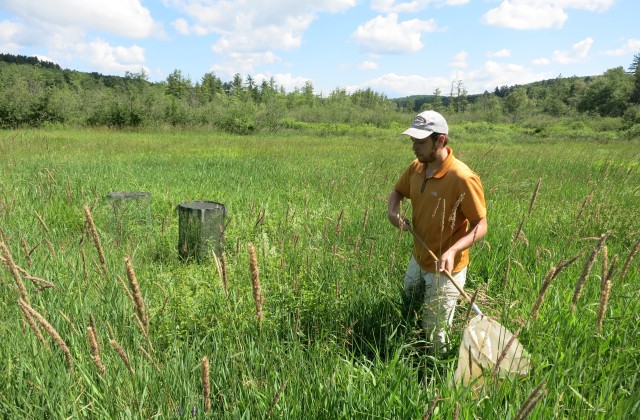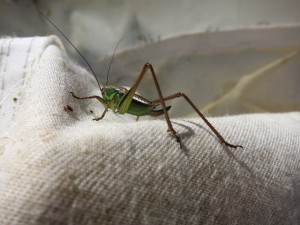Yale Student Conducts Field Experiments in Norfolk
Does the presence of roads affect the plants in a field?
By Wiley Wood
On a hot morning in late June, Jeffrey Smith walks around in circles in a field in Norfolk, swatting at the grasses with a canvas net. He is sampling the insect population. At the end of a few minutes, the net holds a variety of grasshoppers, katydids, spiders, moths, aphids and beetles, which Smith dumps into a plastic bag, squirts with acetone and seals up.
Smith is working toward his master’s degree at the Yale School of Forestry and Environmental Studies. His lab, under the direction of Oswald Schmitz, has studied old fields extensively, tracing the effect of insects on plant communities. Leaf-eating and sap-sucking insects limit plant growth and alter the composition of a field’s flora. But carnivorous insects (chiefly spiders), by preying on grasshoppers and aphids, also affect what plants grow and how much.
The question Smith has posed is whether the presence of development, largely in the form of roads, will affect the insect population in old fields enough to produce measurable differences in the plant community.
The field in Norfolk is only one of 16 sites Smith is monitoring in Connecticut. All are of approximately the same size and have been abandoned for at least 10 years. Those near New Haven and New London fall on the more developed end of the spectrum, those in Mystic and Newtown somewhere in the middle and those in Eastford and Norfolk are less developed. Smith, who will make three sampling visits to each site during the summer, drives over 15,000 miles during his field season.
In addition to sweep-netting, Smith collects insects using pitfall traps, essentially coffee cans sunk into the ground and filled with ethylene glycol. From these, Smith has counted and identified 10,322 individual specimens from his research sites in the month of June.Already, he is beginning to see an expected pattern, with relatively undeveloped sites yielding more specimens and developed ones fewer. A field in Newtown had 1,391 individual insects and one just west of Bridgeport only 112. Among the insects Smith has found are a northern mole cricket the size of a small rodent, a mile-a-minute weevil (an introduced biological control agent for mile-a-minute weed) and a variety of brightly colored tortoise beetles.
At the end of the season, Smith will evaluate the plant communities in his test sites closely. To begin assessing the effect of insects on plant biomass and diversity, he has set up a series of cylindrical cages in each field, half of them with screens that exclude insects and half without. Even during the late June visit, the screened-off cages held visibly more plant material: the grasses grew higher and the forbs had more leaves.
An interesting finding of the Yale lab’s research on plant and insect communities in New England’s old fields is that predation of plants by herbivorous insects, while limiting growth, actually increases diversity. Dominant plants are made less dominant, and less productive plants get more space. Smith will examine whether the plants protected from predators inside his screened cages will show increased size and diminished variety.
Stepping back from the minutia of his research project, Smith points to the importance of basing policy decisions on factual knowledge. Whether we encourage or limit development, it’s as well to know what the effects will be.


